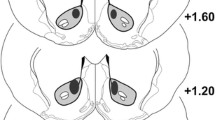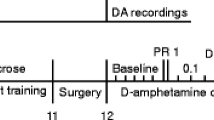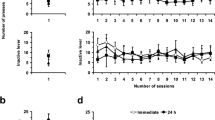Abstract
Rationale
Early onset of alcohol drinking has been associated with alcohol abuse in adulthood. The neurobiology of this phenomenon is unclear, but mesolimbic dopamine pathways, which are dynamic during adolescence, may play a role.
Objectives
We investigated the impact of adolescent binge-like alcohol on phasic dopaminergic neurotransmission during adulthood.
Methods
Rats received intermittent intragastric ethanol, water, or nothing during adolescence. In adulthood, electrically evoked dopamine release and subsequent uptake were measured in the nucleus accumbens core at baseline and after acute challenge of ethanol or saline.
Results
Adolescent ethanol exposure did not alter basal measures of evoked dopamine release or uptake. Ethanol challenge dose-dependently decreased the amplitude of evoked dopamine release in rats by 30–50 % in control groups, as previously reported, but did not alter evoked release in ethanol-exposed animals. To address the mechanism by which ethanol altered dopamine signaling, the evoked signals were modeled to estimate dopamine efflux per impulse and the velocity of the dopamine transporter. Dopamine uptake was slower in all exposure groups after ethanol challenge compared to saline, while dopamine efflux per pulse of electrical stimulation was reduced by ethanol only in ethanol-naive rats.
Conclusions
The results demonstrate that exposure to binge levels of ethanol during adolescence blunts the effect of ethanol challenge to reduce the amplitude of phasic dopamine release in adulthood. Large dopamine transients may result in more extracellular dopamine after alcohol challenge in adolescent-exposed rats and may be one mechanism by which alcohol is more reinforcing in people who initiated drinking at an early age.




Similar content being viewed by others
References
Adalsteinsson E, Sullivan EV, Mayer D, Pfefferbaum A (2006) In vivo quantification of ethanol kinetics in rat brain. Neuropsychopharmacology 31(12):2683–2691
Alaux-Cantin S, Warnault V, Legastelois R, Botia B, Pierrefiche O, Vilpoux C, Naassila M (2013) Alcohol intoxications during adolescence increase motivation for alcohol in adult rats and induce neuroadaptations in the nucleus accumbens. Neuropharmacology 67:521–531
Andersen SL, Thompson AT, Rutstein M, Hostetter JC, Teicher MH (2000) Dopamine receptor pruning in prefrontal cortex during the periadolescent period in rats. Synapse 37(2):167–169
Andersen SL, Thompson AP, Krenzel E, Teicher MH (2002) Pubertal changes in gonadal hormones do not underlie adolescent dopamine receptor overproduction. Psychoneuroendocrinology 27(6):683–691
Badanich KA, Maldonado AM, Kirstein CL (2007) Chronic ethanol exposure during adolescence increases basal dopamine in the nucleus accumbens septi during adulthood. Alcohol Clin Exp Res 31(5):895–900
Benoit-Marand M, O’Donnell P (2008) D2 dopamine modulation of corticoaccumbens synaptic responses changes during adolescence. Eur J Neurosci 27(6):1364–1372
Broadwater M, Spear LP (2013) Consequences of ethanol exposure on cued and contextual fear conditioning and extinction differ depending on timing of exposure during adolescence or adulthood. Behav Brain Res 256:10–19
Budygin EA, Phillips PE, Robinson DL, Kennedy AP, Gainetdinov RR, Wightman RM (2001a) Effect of acute ethanol on striatal dopamine neurotransmission in ambulatory rats. J Pharmacol Exp Ther 297(1):27–34
Budygin EA, Phillips PE, Wightman RM, Jones SR (2001b) Terminal effects of ethanol on dopamine dynamics in rat nucleus accumbens: an in vitro voltammetric study. Synapse 42(2):77–79
Budygin EA, Mathews TA, Lapa GB, Jones SR (2005) Local effects of acute ethanol on dopamine neurotransmission in the ventral striatum in C57BL/6 mice. Eur J Pharmacol 523(1–3):40–45
Budygin EA, Oleson EB, Mathews TA, Lack AK, Diaz MR, McCool BA, Jones SR (2007) Effects of chronic alcohol exposure on dopamine uptake in rat nucleus accumbens and caudate putamen. Psychopharmacology (Berl) 193(4):495–501
Chartier KG, Hesselbrock MN, Hesselbrock VM (2010) Development and vulnerability factors in adolescent alcohol use. Child Adolesc Psychiatr Clin N Am 19(3):493–504
Coleman LG Jr, He J, Lee J, Styner M, Crews FT (2011) Adolescent binge drinking alters adult brain neurotransmitter gene expression, behavior, brain regional volumes, and neurochemistry in mice. Alcohol Clin Exp Res 35(4):671–688
Crews F, He J, Hodge C (2007) Adolescent cortical development: a critical period of vulnerability for addiction. Pharmacol Biochem Behav 86(2):189–199
Crippens D, White ML, George MA, Jaworski JN, Brunner LJ, Lancaster FE, Gonzales RA (1999) Gender differences in blood levels, but not brain levels, of ethanol in rats. Alcohol Clin Exp Res 23(3):414–420
Di Chiara G, Imperato A (1985) Ethanol preferentially stimulates dopamine release in the nucleus accumbens of freely moving rats. Eur J Pharmacol 115(1):131–132
Ernst M, Fudge JL (2009) A developmental neurobiological model of motivated behavior: anatomy, connectivity and ontogeny of the triadic nodes. Neurosci Biobehav Rev 33(3):367–382
Eshleman AJ, Henningsen RA, Neve KA, Janowsky A (1994) Release of dopamine via the human transporter. Mol Pharmacol 45(2):312–316
Gessa GL, Muntoni F, Collu M, Vargiu L, Mereu G (1985) Low doses of ethanol activate dopaminergic neurons in the ventral tegmental area. Brain Res 348(1):201–203
Grant BF, Dawson DA (1998) Age of onset of drug use and its association with DSM-IV drug abuse and dependence: results from the National Longitudinal Alcohol Epidemiologic Survey. J Subst Abus 10(2):163–173
Jacobson-Pick S, Richter-Levin G (2012) Short- and long-term effects of juvenile stressor exposure on the expression of GABAA receptor subunits in rats. Stress 15(4):416–424
Jones SR, Mathews TA, Budygin EA (2006) Effect of moderate ethanol dose on dopamine uptake in rat nucleus accumbens in vivo. Synapse 60(3):251–255
Jucaite A, Forssberg H, Karlsson P, Halldin C, Farde L (2010) Age-related reduction in dopamine D1 receptors in the human brain: from late childhood to adulthood, a positron emission tomography study. Neuroscience 167(1):104–110
Karkhanis AN, Rose JH, Huggins KN, Konstantopoulos JK, Jones SR (2015) Chronic intermittent ethanol exposure reduces presynaptic dopamine neurotransmission in the mouse nucleus accumbens. Drug Alcohol Depend 150:24–30
Kennedy RT, Jones SR, Wightman RM (1992) Dynamic observation of dopamine autoreceptor effects in rat striatal slices. J Neurochem 59(2):449–455
Liu W, Crews FT (2015) Adolescent intermittent ethanol exposure enhances ethanol activation of the nucleus accumbens while blunting the prefrontal cortex responses in adult rat. Neuroscience 293:92–108
Maiya R, Buck KJ, Harris RA, Mayfield RD (2002) Ethanol-sensitive sites on the human dopamine transporter. J Biol Chem 277(34):30724–30729
Mathews TA, John CE, Lapa GB, Budygin EA, Jones SR (2006) No role of the dopamine transporter in acute ethanol effects on striatal dopamine dynamics. Synapse 60(4):288–294
Mayfield RD, Maiya R, Keller D, Zahniser NR (2001) Ethanol potentiates the function of the human dopamine transporter expressed in Xenopus oocytes. J Neurochem 79(5):1070–1079
McClory AJ, Spear LP (2014) Effects of ethanol exposure during adolescence or in adulthood on Pavlovian conditioned approach in Sprague–Dawley rats. Alcohol 48(8):755–763
McCutcheon JE, Marinelli M (2009) Age matters. Eur J Neurosci 29(5):997–1014
McCutcheon JE, Conrad KL, Carr SB, Ford KA, McGehee DS, Marinelli M (2012) Dopamine neurons in the ventral tegmental area fire faster in adolescent rats than in adults. J Neurophysiol 108(6):1620–1630
Naneix F, Marchand AR, Di Scala G, Pape JR, Coutureau E (2012) Parallel maturation of goal-directed behavior and dopaminergic systems during adolescence. J Neurosci 32(46):16223–16232
NIAAA (2004) Binge drinking defined. NIAAA Newslett 3:3
Patrick ME, Schulenberg JE, Martz ME, Maggs JL, O’Malley PM, Johnston LD (2013) Extreme binge drinking among 12th-grade students in the United States: prevalence and predictors. JAMA Pediatr 167(11):1019–1025
Robinson DL, Volz TJ, Schenk JO, Wightman RM (2005) Acute ethanol decreases dopamine transporter velocity in rat striatum: in vivo and in vitro electrochemical measurements. Alcohol Clin Exp Res 29(5):746–755
Robinson DL, Howard EC, McConnell S, Gonzales RA, Wightman RM (2009) Disparity between tonic and phasic ethanol-induced dopamine increases in the nucleus accumbens of rats. Alcohol Clin Exp Res 33(7):1187–1196
Schier CJ, Dilly GA, Gonzales RA (2013) Intravenous ethanol increases extracellular dopamine in the medial prefrontal cortex of the Long-Evans rat. Alcohol Clin Exp Res 37(5):740–747
Shnitko TA, Kennerly LC, Spear LP, Robinson DL (2014) Ethanol reduces evoked dopamine release and slows clearance in the rat medial prefrontal cortex. Alcohol Clin Exp Res 38(12):2969–2977
Sombers LA, Beyene M, Carelli RM, Wightman RM (2009) Synaptic overflow of dopamine in the nucleus accumbens arises from neuronal activity in the ventral tegmental area. J Neurosci 29(6):1735–1742
Spear LP (2014) Adolescents and alcohol: acute sensitivities, enhanced intake, and later consequences. Neurotoxicol Teratol 41:51–59
Spear LP (2015) Adolescent alcohol exposure: are there separable vulnerable periods within adolescence? Physiol Behav
Spear LP, Swartzwelder HS (2014) Adolescent alcohol exposure and persistence of adolescent-typical phenotypes into adulthood: a mini-review. Neurosci Biobehav Rev 45:1–8
Spear LP, Varlinskaya EI (2005) Adolescence. Alcohol sensitivity, tolerance, and intake. Recent Dev Alcohol 17:143–159
Spear LP, Varlinskaya EI (2010) Sensitivity to ethanol and other hedonic stimuli in an animal model of adolescence: implications for prevention science? Dev Psychobiol 52(3):236–243
Spoelder M, Tsutsui KT, Lesscher HM, Vanderschuren LJ, Clark JJ (2015) Adolescent alcohol exposure amplifies the incentive value of reward-predictive cues through potentiation of phasic dopamine signaling. Neuropsychopharmacology
Toalston JE, Deehan GA Jr, Hauser SR, Engleman EA, Bell RL, Murphy JM, Truitt WA, McBride WJ, Rodd ZA (2014) Reinforcing properties and neurochemical response of ethanol within the posterior ventral tegmental area are enhanced in adulthood by periadolescent ethanol consumption. J Pharmacol Exp Ther 351(2):317–326
Trantham-Davidson H, Burnett EJ, Gass JT, Lopez MF, Mulholland PJ, Centanni SW, Floresco SB, Chandler LJ (2014) Chronic alcohol disrupts dopamine receptor activity and the cognitive function of the medial prefrontal cortex. J Neurosci 34(10):3706–3718
Turner PV, Vaughn E, Sunohara-Neilson J, Ovari J, Leri F (2012) Oral gavage in rats: animal welfare evaluation. J Am Assoc Lab Anim Sci 51(1):25–30
Varlinskaya EI, Spear LP, Spear NE (2001) Acute effects of ethanol on behavior of adolescent rats: role of social context. Alcohol Clin Exp Res 25(3):377–385
Varlinskaya EI, Truxell E, Spear LP (2014) Chronic intermittent ethanol exposure during adolescence: effects on social behavior and ethanol sensitivity in adulthood. Alcohol 48(5):433–444
Volkow ND, Wang GJ, Fowler JS, Logan J, Hitzemann R, Ding YS, Pappas N, Shea C, Piscani K (1996) Decreases in dopamine receptors but not in dopamine transporters in alcoholics. Alcohol Clin Exp Res 20(9):1594–1598
White AM, Kraus CL, Swartzwelder H (2006) Many college freshmen drink at levels far beyond the binge threshold. Alcohol Clin Exp Res 30(6):1006–1010
Wightman RM, Zimmerman JB (1990) Control of dopamine extracellular concentration in rat striatum by impulse flow and uptake. Brain Res Brain Res Rev 15(2):135–144
Wood MD, Nagoshi CT, Dennis DA (1992) Alcohol norms and expectations as predictors of alcohol use and problems in a college student sample. Am J Drug Alcohol Abuse 18(4):461–476
Wu Q, Reith ME, Wightman RM, Kawagoe KT, Garris PA (2001) Determination of release and uptake parameters from electrically evoked dopamine dynamics measured by real-time voltammetry. J Neurosci Methods 112(2):119–133
Acknowledgments
Authors thank Dr. Elena Varlinskaya for comments on the results in this study. This research was funded by the National Institute of Alcoholism and Alcohol Abuse NADIA project (U01 AA019972 to LPS) and the UNC Bowles Center for Alcohol Studies. Salary support for DLR was also provided by grant U24 AA020024 of the NADIA project and Project 3 of P60 AA011605.
Conflict of interest
Authors have no conflict of interests to declare.
Author information
Authors and Affiliations
Corresponding author
Rights and permissions
About this article
Cite this article
Shnitko, T.A., Spear, L.P. & Robinson, D.L. Adolescent binge-like alcohol alters sensitivity to acute alcohol effects on dopamine release in the nucleus accumbens of adult rats. Psychopharmacology 233, 361–371 (2016). https://doi.org/10.1007/s00213-015-4106-8
Received:
Accepted:
Published:
Issue Date:
DOI: https://doi.org/10.1007/s00213-015-4106-8




